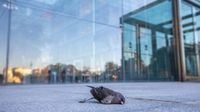It was just after 10 p.m. on October 8, 2025, when the Cornell Lab of Ornithology’s BirdCast project captured a record-shattering moment: 1.25 billion birds were in flight across the United States, winging their way south for the winter. For bird enthusiasts and scientists alike, this was a night to remember—an awe-inspiring spectacle of migration, and the highest count ever recorded since BirdCast began tracking the phenomenon over two decades ago. Just weeks earlier, on September 25, BirdCast had logged another milestone, with 1.22 billion birds in the air at once. These astronomical numbers may sound like something out of a storybook, but they’re all too real—and they come with a dark undercurrent that’s become increasingly hard to ignore.
Every fall and spring, as hundreds of millions of birds traverse North America, their journeys are fraught with invisible dangers. Chief among them: glass. According to the U.S. Geological Survey’s Bird Banding Lab, nearly 2 billion birds die each year in the United States after colliding with windows, and some studies estimate the toll could be as high as 3 billion. NPR reports that, aside from cats and habitat loss, glass is now the second biggest threat to birds in America. “They can be flying up to 30 miles per hour when they hit the glass, so it’s a very loud thunk,” said Lisbeth Fuisz, a volunteer with Lights Out DC, a group dedicated to reducing bird deaths during migration. The injuries are often fatal—concussions, broken bones, and internal trauma are common even if a stunned bird manages to fly away at first.
The problem isn’t just in the big cities or at dizzying heights. Most collisions take place close to the ground, below the treeline, where transparent or reflective glass tricks birds into thinking they can fly through or that they’re heading toward open sky or trees. Cities like Washington, D.C., Chicago, Philadelphia, Dallas, and San Diego have become hotspots for data collection, with volunteers combing the streets at dawn to collect dead or injured birds before they’re swept away or scavenged. “It is becoming now a question of, how do we do it at a scale big enough to save a billion birds,” said Bryan Lenz of the American Bird Conservancy to NPR.
Some buildings, by virtue of their design, become notorious death traps. In Washington, D.C., NPR notes that about half a dozen downtown buildings account for a disproportionate share of bird deaths. “This is a problematic building,” Fuisz said, pointing out a glass-walled office complex that seems to funnel birds straight into its atrium. The problem is echoed in other cities. On the night of October 4, 2023, nearly 1,000 birds died in a single night after colliding with the glass façade of Chicago’s McCormick Place Convention Center, a building perched on the Lake Michigan shoreline in the heart of a major migratory flyway. The tragedy made national headlines and catalyzed action.
In the wake of that event, the Metropolitan Pier and Exposition Authority installed bird-safe film on the windows at McCormick Place. The results were dramatic: the following fall, bird deaths dropped by roughly 95%. “The numbers are awesome. We’re very proud of it,” said Patrick Allen, the center’s chief operating officer, according to NPR. The fix wasn’t cheap—over a million dollars for a building with enough glass to cover two football fields—but the impact was undeniable. Advocates point out that costs can be much lower when bird-friendly designs are incorporated into new construction or major renovations from the outset.
Yet, the scale of the problem means that solutions can’t stop at landmark buildings. Residential homes, with their many windows, collectively pose a massive risk. The Bird Collision Prevention Alliance, a coalition formed after the McCormick Place incident and now including over a hundred organizations, recommends that homeowners start by treating any window that’s been the site of a collision, especially those near birdfeeders or fruit trees. The Michigan Audubon Society suggests breaking up window reflections with stickers or paint, placing bird feeders at least 30 feet from windows, and reducing artificial lighting at night. “You would think that most buildings would care and want to fix the problem,” said Stephanie Dalke, another Lights Out DC volunteer. “It turns out, it can be complicated and expensive to treat a commercial building.”
In Michigan, the Bird Center of Michigan in Saline, managed by Eastern Michigan University alumnus Marissa Jardine, is on the front lines of treating birds injured by window collisions and other hazards. Jardine, who began as an intern at the Center, now manages the clinic and fields calls from across the region, including from EMU’s own campus. “EMU has high buildings with glass windows, and during the night, songbirds can run into windows and have collisions,” Jardine told The Echo. Her advice for those who find an injured bird: gently cover it with a towel, place it in a box, and call the Bird Center for further instructions. “Do not give food or water,” she cautioned, as improper feeding can do more harm than good, especially for fledglings.
The Bird Center’s work extends beyond emergency care. They offer educational programs, seek volunteers for three-hour shifts during the fall and winter, and provide internships for students interested in wildlife rehabilitation. The Center also helps identify local and migratory species—ruby-crowned kinglets, eastern wood-pewees, rose-breasted grosbeaks, and bay-breasted warblers are just a few of the birds passing through the Ypsilanti area during the September to October migration peak, as tracked by BirdCast’s live dashboard. The Center also keeps a close eye on disease. With avian flu cases on the rise, Jardine urges vigilance, especially around waterfowl like geese and ducks, which can spread the illness to other birds.
Global efforts to raise awareness are growing. Each year, the Fatal Light Awareness Program in Toronto promotes Global Bird Rescue Week, encouraging people worldwide to report bird-window collisions. By September 27, 2025, volunteers had logged 111,492 collisions that year, resulting in at least 79,000 bird deaths. The registry, as grim as it is, helps scientists and advocates track patterns and push for change.
For those who love backyard birdwatching, there’s some good news: bird feeders are fine, as long as they’re kept clean to prevent disease. But hand-feeding, especially of injured birds, is discouraged. “Bird feeders are fine,” Jardine said, “Make sure to clean the bird feeder to avoid disease factors.” Feeding geese or ducks with bread, or hand-feeding wild birds, can lead to nutritional deficiencies and infections.
As the scale of migration continues to astound—with more than a billion birds in the night sky at once—it’s clear that the challenge of keeping these travelers safe is a shared one. From major cities to suburban backyards, the responsibility to make the built environment safer for birds is becoming part of the conversation. The solutions are out there, and as recent successes show, they can work wonders—if people are willing to put them into practice.
For those interested in learning more or helping out, organizations like the Cornell Lab of Ornithology, Audubon, and the Bird Center of Michigan offer resources, volunteer opportunities, and up-to-date migration tracking. Each step, however small, brings the hope of fewer birds meeting an untimely end on their epic journeys.




